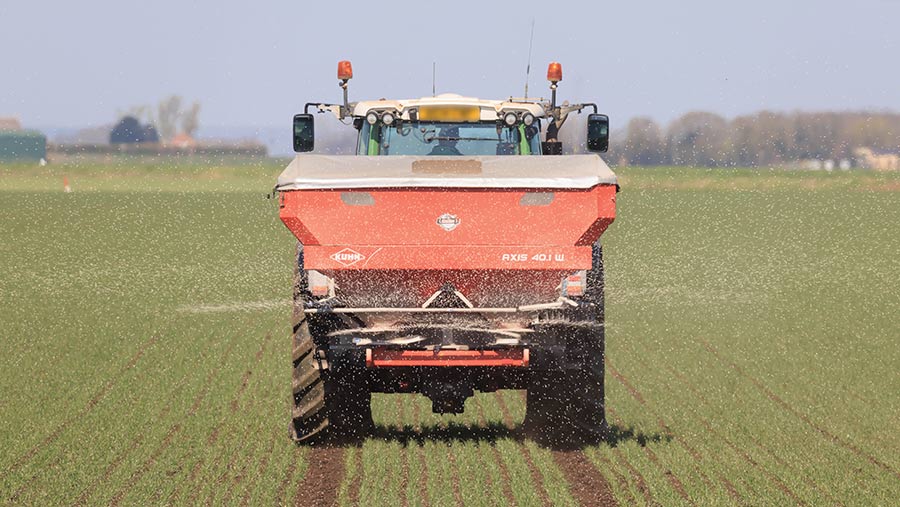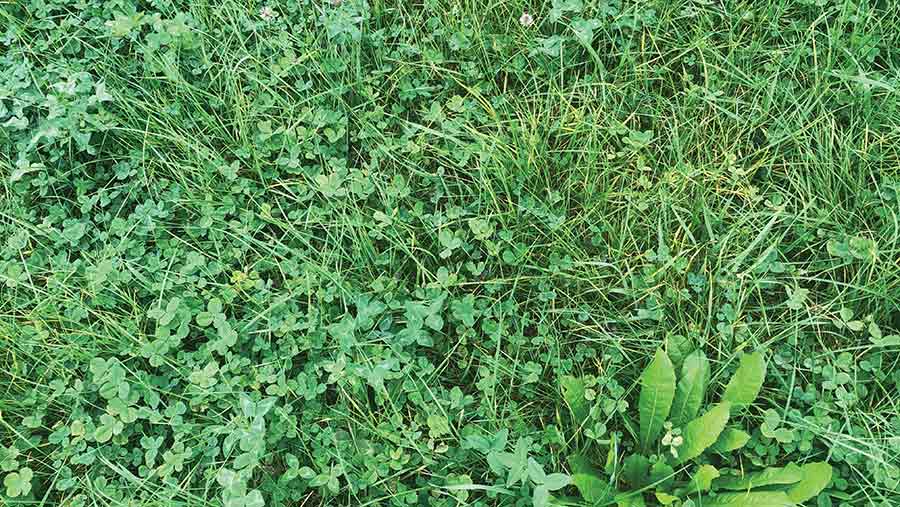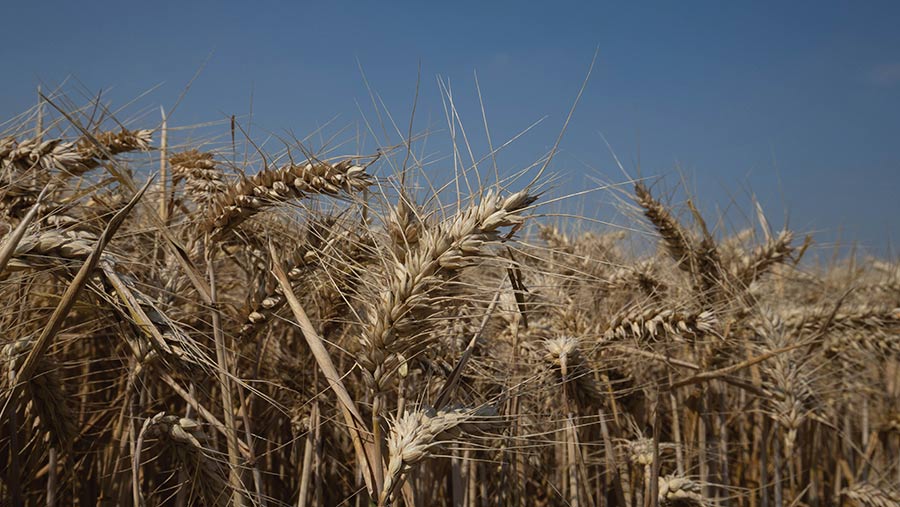Herbal leys help halve nitrogen fertiliser use for wheat
 © Tim Scrivener
© Tim Scrivener Winter wheat growers could halve their nitrogen fertiliser rates after using a three-year herbal ley and not see a fall in yield compared with an all-arable rotation.
Introducing a multi-species herbal ley, which is grazed by livestock, can increase carbon capture and lower soil density, and show the fertiliser saving for two successive wheat crops.
Dr Lydia Smith, head of the Innovation Farm at crop consultants Niab, used a trial to compare wheat crops following a herbal ley and also a grass-clover mix with an arable rotation.
See also: New wheat and barley varieties rejuvenate Recommended Lists
“When the herbal leys were grazed by sheep, the yield of the next two crops of winter wheat were equal to the arable rotation control, but the nitrogen rate was cut to 110kg/ha from 220kg/ha in the arable rotation,” she told a recent conference.
The ley, included herbs such as sainfoin, plantain and chicory, legumes such as clovers and also grasses, were grown over three years across four sites in Leicestershire, Cambridgeshire, Essex and Norfolk, and followed by two wheat crops.
Wheat yields
In the first year of the trial at harvest 2021, one of the sites at Duxford in Cambridgeshire gave a similar wheat yield of 10t/ha following the herbal ley and in the arable rotation, and then again a similar 7t/ha in a generally poor-yielding 2022.
The winter wheats grown after the herbal ley gave a higher grain yield than the grass-clover mix, while the herbal ley also gave better liveweight gains for the grazing sheep and lambs.
In the trial, Lydia was looking to target arable land in eastern England where no livestock had been used recently, to improve soil quality and organic matter levels, and so make wheat rotations more resilient.
With national wheat and oilseed rape yields showing signs of plateauing and the areas of each crop falling, she was looking to change rotations to improve soil fertility and create a more sustainable system.
The UK winter wheat area for harvest 2024 is set to decline by 1.3% to 1.698m ha and oilseed rape to fall by 16% to 325,000ha, according to an AHDB Early Bird survey in November.

© MAG/Emma Gillbard
Establishment technique
The wheat in the Niab trial was established after the leys using ploughing and direct drilling with no significant yield difference between the two techniques.
However, deep rooting herbs, such as sainfoin and chicory, were more difficult to control in direct drilled wheat crops.
Lydia also looked at the use of cover crops to improve soil quality.
These covers included a legume such as vetch, a brassica such as fodder radish and a cereal like oats to help improve soil structure and organic matter and give a break to any disease carryover.
These cover crops did lock up nutrients in the upper layers of the soil which helped avoid nitrogen loss, but the crops were not in the ground for long enough to produce a significant impact on soil quality.
She concluded that the herbal ley helped to revive tired arable land with a big beneficial effect on soil quality, while after that initial increase, cover crops could help to produce small steady rises in soil quality.
These herbal leys and cover crops could be used as part of environmental schemes such as the Sustainable Farming Incentive (SFI) or Countryside Stewardship (CS).
Herbal leys pay £382/ha a year in SAM3 under SFI and the same under GS4 in CS, while cover crops pay £129/ha a year in SAM2 in SFI and a similar amount under SW6 in CS.

© Tim Scrivener
Wheat import gap could widen with move to sustainability
Flour millers are set to import an increased amount of milling wheat after a poor quality UK harvest last summer, and this could increase further with new sustainability farm policies.
A falling winter wheat area and a smaller area of milling varieties being grown are exacerbating this domestic shortfall, and one leading miller is encouraging growers to move back to Group 1 milling varieties with the carrot of a £70/t premium.
George Mason, senior executive at Heygates, one of Britain’s biggest millers, is concerned that the emphasis on environmental schemes will hit food security in terms of less milling wheat being grown.
UK conundrum
“The UK conundrum is that sustainability, regenerative agriculture, carbon saving, fertiliser management and environment schemes will all lead to less wheat production,” he says.
George is looking to encourage wheat growers to pick the right milling wheat variety and then target 13% grain protein to take advantage of current premiums and the recent fall in nitrogen fertiliser prices.
“Target 13% and if you miss it, it is not a problem, as every flour miller will take wheat down to 12% protein,” he adds.
Most breadmakers look for milling wheat of 13% protein, a Hagberg of 250 and specific weight of 76kg/hl, but they will often take milling wheat down to 12-220-74 with a price reduction.
In the 2023 wheat harvest, only 13% of Group 1 milling varieties made the full specification of 13-250-76, but 53% of Group 1s passed the lower 12-220-74 target.
Despite the present high demand for domestic milling wheat, George says more environmental farming policies will lead to land being taken out of production, and reduced levels of nitrogen fertiliser being used on arable land still being cropped.
“Fertiliser is yield, and protein. A reduction in fertiliser use will lead to less yield and lower protein,” he says.
Shrinking area
The UK wheat area has been slowly falling for the past 20 years as growers have looked to more diverse rotations, in part to counter blackgrass.
The wheat harvest over the past two decades has varied from a low of 9.658m tonnes in 2020 up to 17.227m tonnes in 2008.
“Environmental issues are taking centre stage and away from the core aim to feed the world,” says George.
Seed sales of Group 1 wheat varieties have fallen 24% since 2017 due largely to the extra costs and risks of producing milling wheat, and then the sharp rise in nitrogen fertiliser prices after Russia invaded Ukraine in February 2022.
Breadmakers in the UK use 3.5m tonnes a year of wheat annually and 1.2m tonnes is likely to be imported this season against 800,000t the previous season, all within the 6.1m tonnes of milling wheat bought each year by millers such as Whitworth, Heygates, ADM and Allied Mills to make bread, cakes, biscuits and flours.
Import gap
This import gap is likely to be filled by German or Canadian wheat, with German wheat fully assured to be 13% protein, and Canadian spring wheats guaranteed to be at a protein level of 17-17.5%.
George says for the future what is needed is a common standard for sustainable wheat production, as some individual millers are offering premiums to growers for using some regenerative farming practices.
The speakers were attending a joint AHDB, Niab and Kent Cereals Group conference on resilience in wheat production held recently in Headcorn, Kent.

